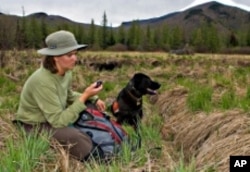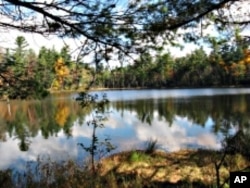New York, the state with the nation's largest metropolitan area, is also home to 2.5 million hectares of protected mountain wilderness. Conservationists believe that protection is why moose - which were nearly wiped out in the area - have started to return, highlighting the value of letting nature take its course.
The moose is the largest member of the deer family. Males can weigh as much as 726 kilos and stand as high as 2-and-a-half meters at the shoulder. Their antlers have a spread of more than a meter. They once ranged throughout the forests that covered the north-eastern part of what's now the United States.
Nearly wiped out
When commercial logging began in New England the early 1800s, loggers realized that one moose could easily feed a camp of 60 men.
Michale Glennon, an ecologist with the Wildlife Conservation Society or WCS, says not only did loggers decimate the moose population, they destroyed its habitat as well.
"These forests were cut very, very heavily and extensively and the moose is a wood creature so the habitat, for one, was changed quite a bit for them," says Glennon.
By the 1860s, moose in New York were virtually wiped out. Dave Gross, curator of The Wild Center at the Natural History Museum of the Adirondacks, says for over a century, there were no sightings of the huge creatures but that changed in the 1970s.
"People noticed back in the 70s or so that maybe one or two moose were straggling back into the Adirondacks," says Gross. "Three years ago, it was estimated that there were 500 or so moose and they think that there's about 800 moose now."
Comeback
Though the moose are a great icon and tourist attraction for the Adirondacks, Gross says too many moose could destroy vegetation and several bird habitats. They also pose a deadly collision risk to motorists because they're difficult to see on the road at night and they weigh about half as much as an average car. Consequently, conservationists are now trying to determine just how many moose have returned.
To do that, they started a project called AROMA or Adirondack Return of Moose Assessment which relies on a group called Working Dogs for Conservation.
"They train dogs to find moose scat," says WCS research scientist Heidi Kretser. "Then from that, through some fun statistics and theory, we'll be able to figure out some general estimate of what the moose population might be."
The dogs' moose tracking adventures have been turned into a movie which is now being shown at the Wild Center. In one scene, a black dog in a red safety vest scouts the area for moose dung. He indicates he's found a pile by abruptly sitting.
The scat may help answer questions about everything from what the moose are eating to why they're coming back or if their numbers are actually increasing locally.
WCS ecologist Glennon says the current theory is that the moose resurgence was facilitated by the laws protecting the preserve, and several corridors of protected land linking the Adirondacks to Maine, Vermont and Canada, which provide safe travel routes for the animals.
Letting nature run its course
"The New York State Forest Preserve is considered to be forever wild. There is no logging of it. There is no selling or transfer of lands in any way so those woods are just growing and doing their woods thing without any sort of alteration by humans," says Glennon.
Moose are not the only animals to benefit from these protected lands; bald eagles, river otters, and ravens, along with more than a dozen other animals, have been returning to the Adirondacks over the last few decades. That's drawn a lot of attention from wildlife conservationists the world over.
"We have had a number of delegations from China and also Siberia come to the Adirondacks to learn how this interaction between people and nature is working out," says Gross. "The Adirondacks is somewhat different than the national parks. In the national park system, all the people are kicked out. There are no people living in the national parks. The unique thing about the Adirondacks is about half the land is owned privately and half is public."
It may take a decade or more to determine if the moose have returned for good. But Kretser thinks the moose's story offers hope for the future.
"I think the moose returning to the Adirondacks is a nice example that in a modern world - where you have lots of housing development, you have lots of issues with pollution, you have lots of issues of fragmentation across the entire landscape - that it is still possible to get restoration of a species to occur naturally."
In other words, she says, when left alone, nature still can do its job.











